(9) 2008 Kame-Jiru-Shi Gyokuro
Gyokuro: any other tea that triggers the same sense of excitement and festivity?
Gyokuro: any other tea that triggers the same sense of excitement and festivity?
Package aside, the dry leaves are a joy to look at:
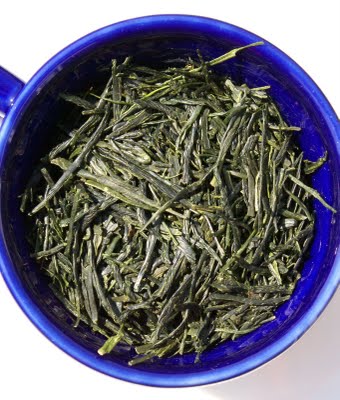 We are on totally different territory than the trio of O-Cha releases reviewed in the last few days (see links at top of post). This is very definitely an asamushi [short-steamed] tea, and the leaves are impeccable, dark emerald in colour, 100% intact, almost exclusively whole. It’s a rare sight among Japanese teas. It has an enjoyable aroma, rather light and elegant, sweet (melon), ungrassy but vaguely reminiscent of spinach, very lightly roasted; compared to the other 2009 shincha teas reviewed in this series, this Uji Gold introduces a sweet-spicy note of vanilla.
We are on totally different territory than the trio of O-Cha releases reviewed in the last few days (see links at top of post). This is very definitely an asamushi [short-steamed] tea, and the leaves are impeccable, dark emerald in colour, 100% intact, almost exclusively whole. It’s a rare sight among Japanese teas. It has an enjoyable aroma, rather light and elegant, sweet (melon), ungrassy but vaguely reminiscent of spinach, very lightly roasted; compared to the other 2009 shincha teas reviewed in this series, this Uji Gold introduces a sweet-spicy note of vanilla.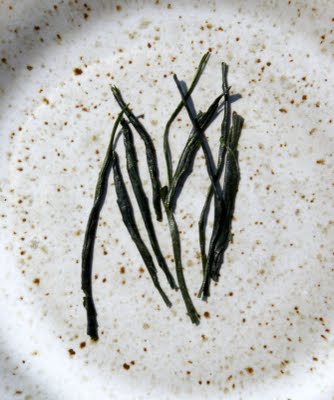 The dry leaf tells a lot about this tea’s characteristics and pretty much preannounces the ups and downs of actually brewing it. As much as I am aesthetically admirative of the leaf quality here, it’s a difficult tea to interpret. It has little to do with Japanese sencha as we know it. Brewed with standard parameters (2g / 120ml / water at 70C / 60–90 seconds) this yields a light greenish-golden colour, and the profile is very close to a continental Chinese green tea. Light-bodied, unpungent, vegetal (in the sense of green beans and spinach, not the more usual grass), with little fruit (melon); only a very minor reminiscence of brothy umami. This profile continues through the second brewing (where Japanese greens usually pack in more oomph). Perhaps a bit of creaminess to the texture (egg custard).
The dry leaf tells a lot about this tea’s characteristics and pretty much preannounces the ups and downs of actually brewing it. As much as I am aesthetically admirative of the leaf quality here, it’s a difficult tea to interpret. It has little to do with Japanese sencha as we know it. Brewed with standard parameters (2g / 120ml / water at 70C / 60–90 seconds) this yields a light greenish-golden colour, and the profile is very close to a continental Chinese green tea. Light-bodied, unpungent, vegetal (in the sense of green beans and spinach, not the more usual grass), with little fruit (melon); only a very minor reminiscence of brothy umami. This profile continues through the second brewing (where Japanese greens usually pack in more oomph). Perhaps a bit of creaminess to the texture (egg custard).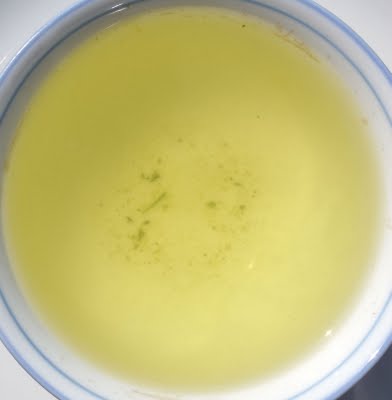
Infusion no. 1: 60 seconds at 70C.
Logically for a whole leaf tea, where the leaf surface to water ratio is far larger than in a fragmented leaf fukamushi [long-steamed] tea such as this, it’s reasonable to increase leaf quantity, water temperature, or both in order to get better extraction and more depth of flavour. From these options, a higher 80–85C temperature is fine, with more palate presence and length (but a finish that’s bit hard), but I’ve been happier with a higher dosage. Move from 2 to 4 grams of dry leaf in the pot (60 seconds for the first brewing, shorter afterwards) and you’re getting a totally different animal. Deeper in colour (though still yellowish rather than jade-green), much more saline and mineral, this reminded me of some avant-garde white wines from Alsace or Friuli in its full terroir presence. I’m interpreting this as a signature of Uji, Japan’s most renowned tea growing location. Still not exactly a typical Japanese sencha, again reminiscent of something more continental, but now a really exciting tea.
As it stands, I found this an eye-opener. Too often we are stuck with what we deem is ‘typical’: an important concept in interpreting any agricultural product but dangerous when it starts to handicap truly individual ones. This 2009 Uji Gold is precisely that: a high-quality product with a distinctive style. I’m sorry to see my 50g pack drawing to an inevitable end.
No mistake: this is Japanese shincha.
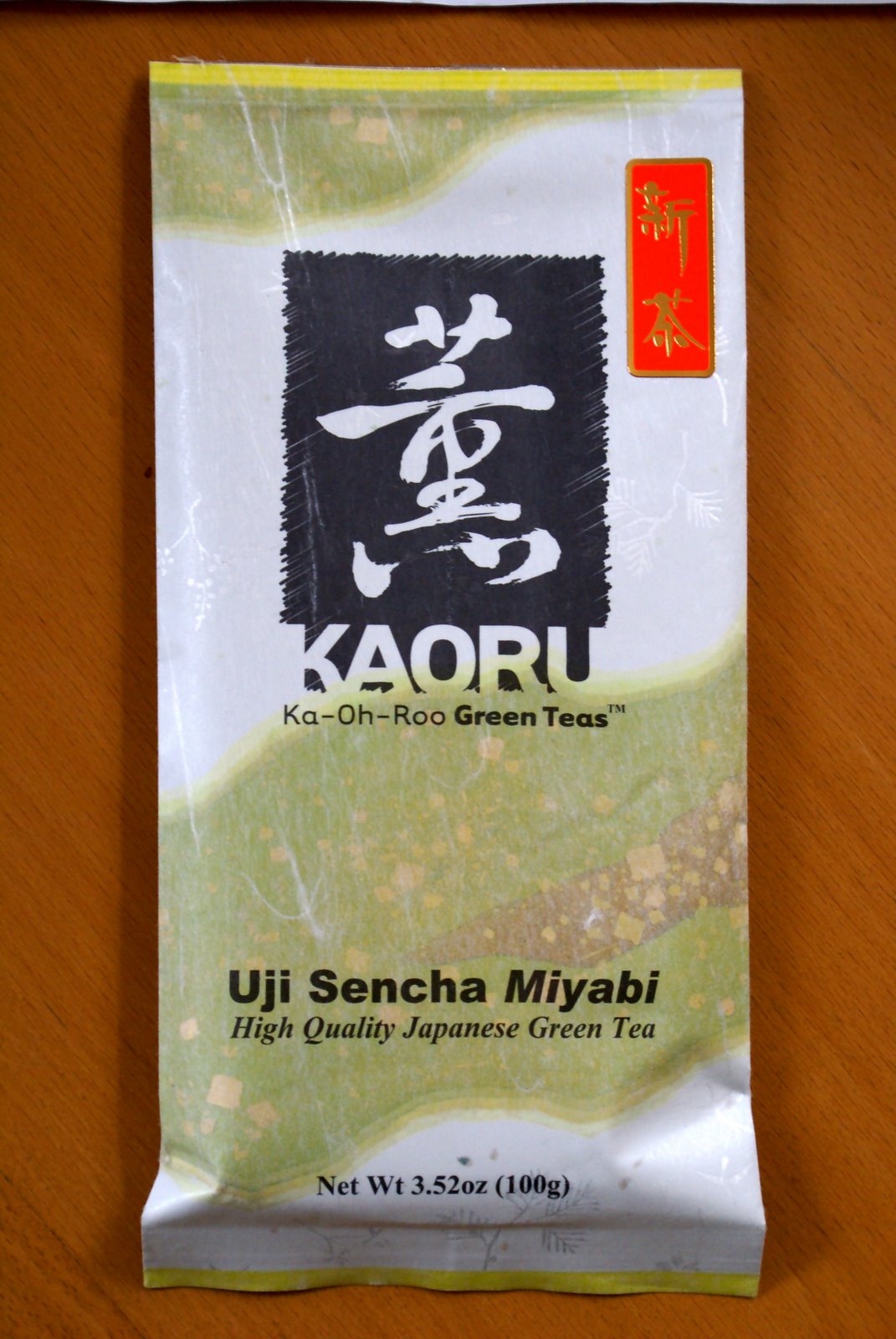
O-Cha consider this one of their best offerings. Unlike the Yutakamidori and Fukamushi Supreme that I’ve reviewed earlier (see links at top of page), this tea is from Uji, perhaps Japan’s most prestigious tea-growing appellation. At $26 per 100g, it surely has a prestigious price tag.
It’s interesting how I disagree with this vendor’s product descriptions. The 2009 Yutakamidori is described as heavy-steamed and this Miyabi as medium-steamed, yet there’s no doubt the latter sees heavier steaming. While the Yutakamidori, to me, is chumushi (click link at top of page to see a picture of spent leaves: there is a mixture of heavily fragmented and nearly intact that I find characteristic of medium steaming), the Miyabi is a finer fragmented tea, and it also shows in the infusion:
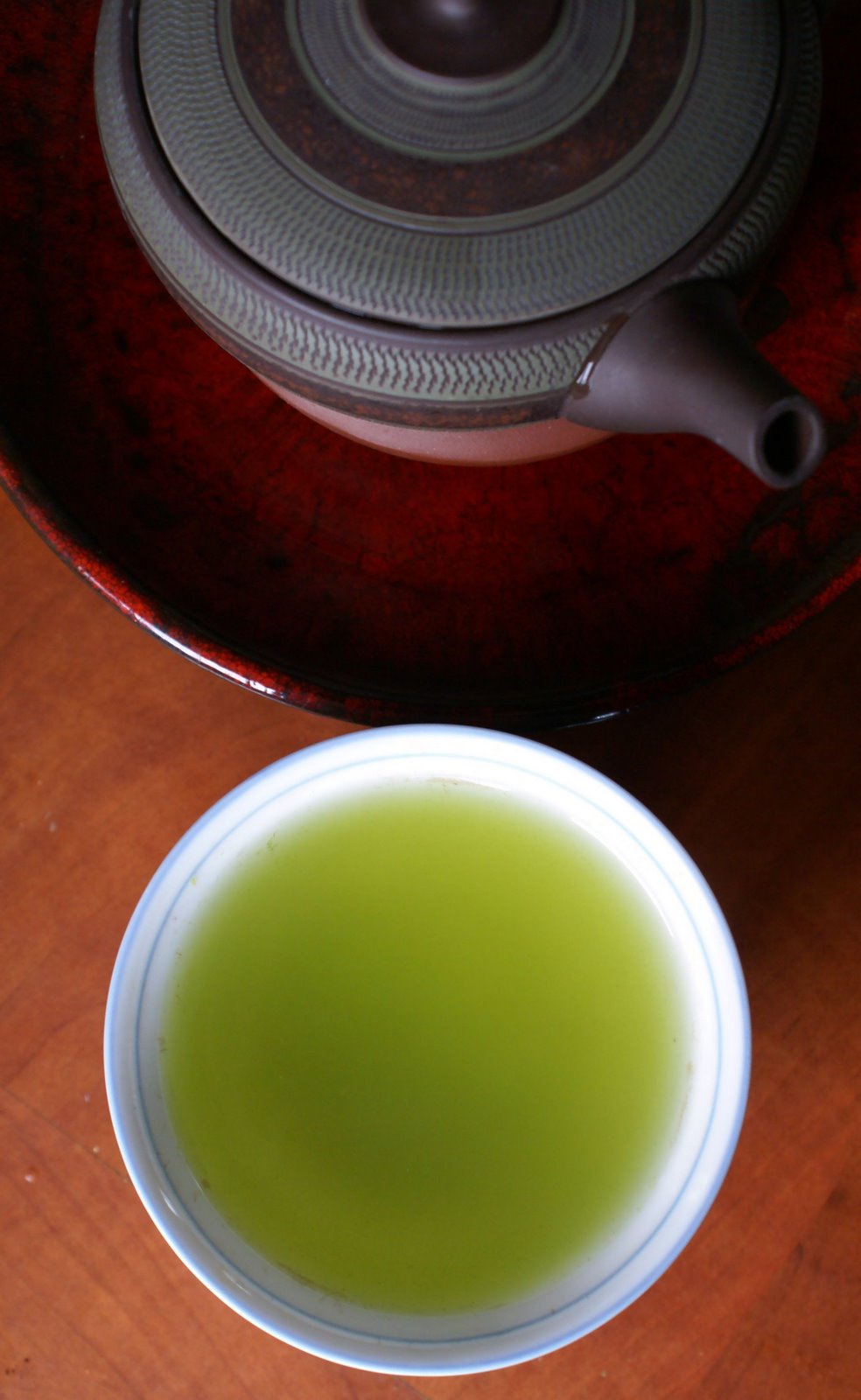
The dry leaf is similar to the 2009 Fukamushi Supreme in aroma, showing a larger-than-life bouquet of ripe exotic fruits that on the whole is reminiscent of a New Zealand Sauvignon Blanc; compared to the Fukamushi Supreme, it is less tangy, sweeter, fruitier (melon, papaya, some kiwi), and really tremendously enjoyable.
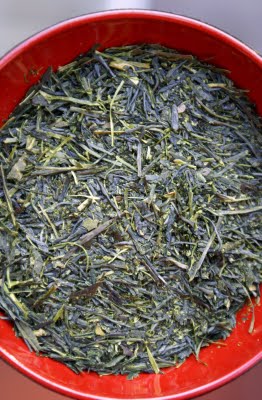
This aromatic register is reflected in the teacup. The scents are elegant and subtle: melon, pomelo, with an underlying vegetality. The combination of sweetness and vegetality (becoming a chewy bitterish seaweedy character when overbrewed) is also to be found in the flavour. There is nearly no astringency but quite a bit of thickness. And interestingly, the second infusion is best in nearly all my trials; while I usually rate my first infusions of Japanese greens highest, this tea is an exception. Somehow, it’s only in the second brewing that flavours seem to come together.
This tea is true to its name: miyabi, ‘elegance’. Despite its obvious thickness and a certain power it focuses around clean, elegant fruit flavours. To get the best of this character, I recommend dosing sparingly: in a comparative tasting with 2, 3 and 4 grams of leaf, the former version was the best.
Is this 2008 showing its age? Honestly, not much. It’s a clean, well-defined, reasonably complex tea of real personality, and it’s perhaps my favourite from the three sencha teas from O-Cha I’ve tried this year. But it’s even more ephemeral than the 2009 offerings from O-Cha, and its plateau of highest quality lasts only a few days from opening the pack; later, there’s a slightly drying seaweedy impression on the palate that’s a telltale sign of a Japanese green going stale. The 2009 is now available and I’m sure it won’t disappoint.
My green teas from 2008 have to move out quickly to make room for 2009s. Longjing, Biluochun, Sencha are all being harvested at the moment, and some are ready for immediate EMS shipment.
But drinking tea up is no easy task. Any tea lover will know the embarras de richesse of a drawer full of samples. With 70 at this moment, I think I am among the least overstocked. Some teas can age, of course, and these will be happy with a few months’ oblivion as I delve into newly delivered 2009s. But fragile green teas – especially those from Japan, in my experience – should ideally be consumed within the year of harvest.
Today’s is definitely a belated note, then. The 2008 Harayama Shincha was made with the first spring harvest of last year. Shincha – ‘new tea’ – is often nicknamed the Beaujolais Nouveau of the tea world. It is equivalent to what the Chinese classify as pre-Qing Ming (or ming qian): the first spring buds plucked before this major Chinese festival that usually falls at the beginning of April. So in essence, this Harayama (a prestigious origin in the prestigious region of Uji) is an early harvest sencha Japanese green tea.
Merchant: Eastteas
Price: £16 / 100g
Brewed in: Korean clay cup (see photos)
Dosage: 4g / 120ml
Leaf: Immaculate elongated pressed leaves boast an impressively consistent dark green. This clearly belongs to the light-steamed family of Japanese tea (a.k.a. asamushi). I somehow found these wonderful leaves representative of the perfectionist Japanese aesthetics. Dry leaf smell is a concentrate of vegetality, with notes of asparagus, artichoke, and especially extra virgin olive oil.
Tasting notes:
1m @ 70C: A typical pale golden / celadon colour. The nose is quite aromatic with a top note I identified as nutmeg. Body is round and flavourful, allying sweetness with vegetal freshness, losing its bite gradually as there is very little overt grassiness: this is true to the shincha sort in being airy, light, without the tang of full-season sencha.
30s @ 70C: Good character, if a little less intensity than the first brewing. With fruity notes a bit lower, the full glutamic scharge is arriving with more power. This tea is easy to overbrew (in fact brewing at 85C results in too much astringency) but if you find the right balance it is really delightful.
80s @ 80C: Now slowly eclipsing into a vague greenish soup. Still pleasant but with limited interest.
Overall this tea has held reasonably well (my notes from November 2008 and this morning are consistent), and although hardly complex, it really delivers very good intensity of spring leaf flavour. Just what shincha should be. I can’t wait to receive my 2009s!
I also draw your attention to the lovely tea items on the photos (also purchased from Eastteas). The handy crackled celadon clay pot and accompanying cup are by Korean potter Mr. Bo Hyun, and have an effortless elegance while being very practical for brewing a single cup of green tea (especially fragmented-leaf, as in this case). The carved wooden tray is my Mr. Kang. It is perfect as a small tea table for one, or for serving three or four guest cups on.